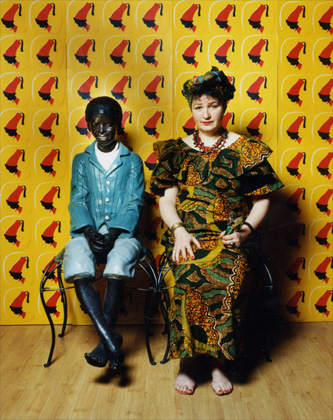Going native was, historically, a phrase to rock the foundations of colonial consensus with implications of betrayal of shared
values as well as moral turpitude. It might have been regarded as eccentrically exotic in the context of Chinese culture, as provokingly masculine in
the Arabian desert but in conjunction with any African culture it would have been regarded as sinking into moral darkness, a great leap down the (social)
Darwinian ladder. Of course, sexual relations with women of other cultures was a slightly different matter, as long as they were not formalised. In any
case, such relations did not necessarily imply acceptance of the culture from which the women came. For a white woman to have ‘gone native’ she
would have to be completely out of control, in relation to the prevailing moral rules and those of her male minder - father, brother, or husband. To
the colonial mind set this represents the ultimate in social anarchy.
Nowadays, the cog has turned a couple of notches. World-wide tourism has fogged the contours and the advent of ethno-fashion and the
visual appropriation and commercial exploitation of exoticism for the home market has meant that we are used to seeing (Western) people dressing themselves
in other cultures. Nevertheless Ponger’s photograph still seems to resonate with colonial history.
The title and the photograph together invite speculation as to the ambiguous relationship between the woman and the adolescent African
(Afro-American?). |
 |
 Despite
the fact that he is a three-dimensional representation and she a ‘real’ person, the fact that both sit on identical chairs exactly aligned
with the background indicates that we are meant to read a certain equality of representation into the work. Since, strictly speaking, ‘going native’ is
a term which applies to someone from the west who adopts the dress and customs of a non-European culture whilst living there, it thus depends on cultural
context and geographical location. This appears to undermine the certainty of the picture in spite of the reference to the Austrian company in the background
and our initial assumptions about who has ‘gone native’. When all is said and done a non-Westerner who assumes the ‘appropriate’ clothing
and customs would never be said to have ‘gone native’. He would have been integrated or assimilated. Put simply, in common with other works
in the series, Ponger is not present as herself, but as representing (aspects of) her culture and its hierarchical assumptions. Despite
the fact that he is a three-dimensional representation and she a ‘real’ person, the fact that both sit on identical chairs exactly aligned
with the background indicates that we are meant to read a certain equality of representation into the work. Since, strictly speaking, ‘going native’ is
a term which applies to someone from the west who adopts the dress and customs of a non-European culture whilst living there, it thus depends on cultural
context and geographical location. This appears to undermine the certainty of the picture in spite of the reference to the Austrian company in the background
and our initial assumptions about who has ‘gone native’. When all is said and done a non-Westerner who assumes the ‘appropriate’ clothing
and customs would never be said to have ‘gone native’. He would have been integrated or assimilated. Put simply, in common with other works
in the series, Ponger is not present as herself, but as representing (aspects of) her culture and its hierarchical assumptions.
|